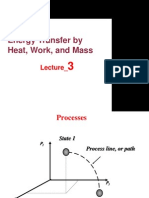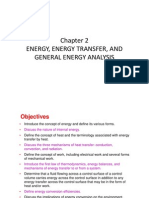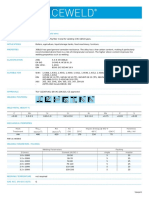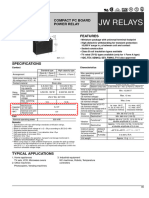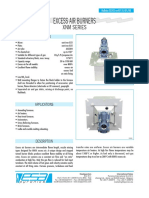Module 2 part 3 ENGINEERING THERMODYNAMICS I
Uploaded by
Felix SaguuModule 2 part 3 ENGINEERING THERMODYNAMICS I
Uploaded by
Felix SaguuENGINEERING THERMODYNAMICS I
Prof. J F Kanyua
Module 2 (Part 3):
1) Flow Process and Application of Energy Equation to Flow
Processes.
A flow process is a process in which matter enters and exits the control
surface and heat and work may also be simultaneously transferred.
In the 1st Law, our definition of work transfer was shaft or external work
i.e. work transferred across the control surface other than at the sites
where matter crosses the control surface.
Work transfer across the control surface at the sites where matter enters
or exits the control surface is referred to as flow work because it is
associated with flow of fluid. (Flow work is also referred to as
displacement work).
From earlier study, it was shown that flowing fluid carries in it both KE
and PE (From Newton’s Laws of Motion) which reside inside the matter
crossing the control surface.
We have also shown that matter contains another form of energy called
Internal Energy (U) (from 1st Law of Thermodynamics).
For a pure substance, the total energy (E) of a pure substance is given by:
E = U + KE + PE + Flow work + Capillary Energy + Electrical Energy +
Magnetic Energy
TUM June 2019 1 of 12
2) Flow Work and Enthalpy:
TUM June 2019 2 of 12
For an element of fluid about to enter into the control volume, the closed
system must be compressed by a volume dV = δm . v
The force p moving through a distance dl = δm . v/A
The work done by the surroundings on the system is given by:
δ W f = pA dl = pA(δm) v/A = pv δm
If there are many entry pints:
𝑛𝑛 𝑛𝑛
W fIN = �1 (dW)f IN) = �1 (pv δm)IN)
R
Similarly:
𝑛𝑛 𝑛𝑛
WfOUT = �1 (dW)f OUT) = �1 (pv δm)OUT)
For the process to be reversible, the difference in pressure (dp) must be
so small such that reversal would occur if the system pressure were
increased by a small amount.
We can therefore assume that at the entrance to the control volume, a
constant pressure p1 acts through a distance dl and performs flow work
given by:
dWf = p1A dl (δm) = p1A dl (δm) v1/A = (p1v1) (δm)
This is work done by surroundings on system. Entry of δm into the
control volume means the fluid in the CV is compressed. The only way
of decompressing the fluid in CV is by making a fluid mass (δm) to exit
at a location designated (say) 2. Decompression results in a return to the
original condition in the CV i.e. equilibrium.
The work done by the element δm exiting is given by (p2 v2) (δm) the
system on the surroundings.
The net flow work done = dWf OUT + dWf IN = (p2 v2 – p1 v1) (δm)
TUM June 2019 3 of 12
∴ Recall dE = dQ – dW
Where dW = dWs + dWf
∴ dQ – dWs - dWf = d[ U + KE + PE + -----------------------]
∴ dQ – dWs = dU + dWf + d(KE) + d(PE) + d(--------------------)
∴ dQ – dWs = dU + (p2 v2 - p1 v1) (δm) + ((d C2)/2) (δm) + gdz(δm) + -----
----------------
dQ – dWs = δm [du + (p2 v2 - p1 v1) + dC2/2 + gdz + ------------------]
∴ dQ – dWs = δm [u2 – u1 + p2 v2 - p1 v1 + dC2/2 + gdz + -----------------]
∴ dQ – dWs = δm [u2 + p2 v2) – (u1 + p1 v1) + dC2/2 + gdz + ------]
If properties are uniform over cross-sections of flow at inlet and outlet:
Let h = u + pv
h is a property since u, p, v are properties.
h called enthalpy (from Greek “to heat with”)
∑ dQ - ∑ dWs = ∑ δm[ --------------------------------- ]
∴ Q – Ws = m [ dh + dC2/2 + gdz + --------------------]
This is the Steady Flow Energy Equation (SFEE) and provides a basis for
analysis of many open flow process.
Note:
Q - ∑ Ws = ∑ m( dh + dC2/2 + gdz)
if there are more than one shaft work devices and more than one inlet
and outlet sites.
The SFEE assumes that:
a) Mass flow rate(s) at inlet(s) is/are constant
TUM June 2019 4 of 12
b) Mass flow rate(s) at outlet(s) is/are constant
c) Properties at any point within the open system do not vary with time.
d) Properties are constant over the cross-section of the flow at inlet(s)
and outlet(s).
e) Heat transfer crossing boundary does so at a uniform rate.
f) Work (shaft) transfer crossing the boundary does so at a uniform rate.
Note:
a) No assumptions made about nature of or configuration of steady
flow within the open system. SFEE applies whether there is viscous
friction or not.
b) The SFEE assumptions are not met in real life, especially assumption
d).
c) Unlike in the closed system where shaft work (churning) was not
important shaft work is very important in open systems.
The SFEE can now be applied to various engineering systems.
During a steady flow process the open system itself does not (strictly
speaking) undergo a process because the properties at all points in the
system remain constant.
4) Concluding Remarks
The following must always be obeyed in any process:
a) Conservation of mass
b) Conservation of energy
c) Newton’s 1st Law of motion
d) Newton’s 2nd Law of motion
e) Newton’s 3rd Law of motion
f) 1st Law of Thermodynamics
g) 2nd Law of Thermodynamics
TUM June 2019 5 of 12
h) Other Laws of Thermodynamics
i) Definitions.
5) Non-Steady Flow Processes
Introduction
Rate of mass flow crossing the boundary of the system at inlet is not
the same as the rate of mass flowing across the boundary of the
system at outlet.
Rate of work done by the fluid or on the fluid is not constant.
Rate of heat transfer to or from the fluid is not constant.
The mass of fluid within the open system varies.
The energy possessed by this mass of fluid in the open system also
varies.
The properties of the fluid at inlet and outlet may vary.
All above happen at the same time.
At inlet: Energy required = ∂𝑚𝑚1 𝑝𝑝1 𝑣𝑣1
At outlet: Energy required = ∂𝑚𝑚1 𝑝𝑝2 𝑣𝑣2
𝐶𝐶12
At inlet: 𝑢𝑢1 + + 𝑔𝑔𝑔𝑔1
2
𝐶𝐶22
At outlet: 𝑢𝑢2 + + 𝑔𝑔𝑔𝑔2
2
𝐶𝐶12
Energy entering system = ∂Q + ∂𝑚𝑚1 (𝑢𝑢1 + + 𝑔𝑔𝑔𝑔1 ) + ∂𝑚𝑚1 𝑝𝑝1 𝑣𝑣1
2
𝐶𝐶22
Energy leaving system = ∂W + ∂𝑚𝑚2 (𝑢𝑢2 + + 𝑔𝑔𝑔𝑔2 ) + ∂𝑚𝑚2 𝑝𝑝2 𝑣𝑣2
2
Energy Balance
Energy entering – Energy leaving = Increase of energy in
system (∂E)
TUM June 2019 6 of 12
𝐶𝐶12 𝐶𝐶22
∴ ∂Q + ∂𝑚𝑚1 (𝑢𝑢1 + + 𝑔𝑔𝑔𝑔1 ) + ∂𝑚𝑚1 𝑝𝑝1 𝑣𝑣1 - ∂W + ∂𝑚𝑚2 (𝑢𝑢2 + + 𝑔𝑔𝑔𝑔2 ) +
2 2
∂𝑚𝑚2 𝑝𝑝2 𝑣𝑣2 = ∂E
Let ∑ ∂Q = Q and ∑∂W = W
Let initial mass in system = m’
Let initial internal energy = u’
Let final mass system = m”
Let final internal energy = u”
∑∂E = m"u" − m′ u′
𝐶𝐶12 𝐶𝐶22
∴ Q – W = - ∂𝑚𝑚1 [𝑢𝑢1 + + 𝑔𝑔𝑔𝑔1 ] + ∂𝑚𝑚2 [𝑢𝑢2 + + 𝑔𝑔𝑔𝑔2 ] + ∂𝑚𝑚2 𝑝𝑝2 𝑣𝑣2 −
2 2
∂𝑚𝑚1 𝑝𝑝1 𝑣𝑣1 + (m"u" − m′ u′ )
Let ℎ1 = 𝑝𝑝1 𝑣𝑣1 + 𝑢𝑢1 and ℎ2 = 𝑝𝑝2 𝑣𝑣2 + 𝑢𝑢2
𝐶𝐶22 𝐶𝐶12
∴ Q – W = ∑∂𝑚𝑚2 (ℎ2 + + 𝑔𝑔𝑔𝑔2 ) − ∑∂𝑚𝑚1 (ℎ1 + + 𝑔𝑔𝑔𝑔1 ) + m”u” − m′ u′
2 2
Also for mass continuity:
Main Entering – Mass Leaving = Increase of mass within the system
boundary
∑∂𝑚𝑚1 - ∑∂𝑚𝑚2 = m” – m’
These are the general energy and mass balance equations for non-steady
flow process. The equations may be modified to deal with different
situations.
Note that for steady flow, the mass entering and the mass leaving the
system are equal and the energy in the system is constant. This reduces
our equation for non-steady flow to that of steady flow as previously
derived.
6) Applications of SFEE to various engineering systems.
TUM June 2019 7 of 12
Work Transfer Devices
The following are work transfer devices:
a) Pump (w –ve ) : Input in form of electrical energy (motor), or
mechanical work (IC engine), etc.
b) Fan (w –ve ) : Input in form of electrical energy (motor).
c) Compressor (w –ve ) : Input in form of electrical energy (motor),
or mechanical work (IC engine), etc.
d) Steam Turbine (w +ve ) : Input in form of enthalpy and KE.
Output in the form of mechanical work which is in turn converted to
electrical energy.
e) Water Turbine ( w + ve) :Input in the form of KE and PE. Output in
the form of mechanical work which is in turn converted to electrical
energy.
f) Internal Combustion Engine (w + ve) : Input in the form of
chemical energy. Output in form of mechanical work.
g) Gas Turbine ( w + ve) : Input in the form of chemical energy.
Output in the form of mechanical work which can be converted to
electrical energy (power generation) or used to operate aircraft.
Pump
A pump is a device used to transfer a liquid from one point to another.
There are many types of pumps but generally classified as:
a) Centrifugal pumps
b) Axial flow pumps
c) Positive displacement pumps
Fan
A fan is a device used to transfer a gas from one point to another with
very limited increase in pressure but with a significant increase in
velocity.
TUM June 2019 8 of 12
Compressor
A compressor is a device used to move a gas or vapour form one point
to another with considerable increase in pressure.
Steam Turbine
A steam (vapour) turbine is a plant which is used to convert the KE, PE,
flow work and internal energy into mechanical shaft work.
Water Turbine
A water turbine is a plant which is used to convert potential energy and
kinetic energy of water into mechanical shaft work.
Internal Combustion Engine
These are based on some of the gas cycles.
Gas Turbine
This is based on one of the gas cycles.
Heat Exchangers:
A heat exchanger is any equipment whose purpose is the exchange of
heat energy between two fluids.
The following equipment are heat exchangers:
a) Coolers
b) Heaters
c) Boilers
d) Condensers
e) Evaporators
f) Furnaces
g) Cooling towers
h) Etc.
TUM June 2019 9 of 12
Items a to f are surface heat exchangers in which the two fluids
exchanging heat do not come into direct contact.
Cooling towers may be of the surface type or direct contact type.
Coolers
Heat exchangers used to reduce the temperature of one fluid by
exchanging heat with another fluid.
The fluid being cooled does not change from one phase to another but
the fluid receiving heat may go through a change of phase.
Heat transfer is from the system (1st fluid) to the surrounding (2nd fluid)
(Q -ve)
Heater
Heat transfer equipment in which the primary fluid (fluid1) has its
temperature raised (without change in phase) by exchanging heat with a
second fluid.
Heat transfer is from surroundings (2nd fluid) to the system.(Q +ve)
Boilers
A boiler is an engineering plant whose purpose is to convert a liquid
(working fluid) to a vapour by application of heat energy. Heat transfer
is from surroundings (products of combustion or nuclear energy) to the
system (working fluid). (Q +ve)
Boiler may consist of the following parts:
Preheater – Heats compressed water to saturation temperature (no
change of phase)
Boiler section – Converts saturated liquid to saturated vapour
Super heater – Raises temperature of vapour from saturated
vapour to super-heated condition
TUM June 2019 10 of 12
Condenser
Heat exchanger in which the primary fluid (working fluid) changes
phase from super-heated or saturated vapour to saturated or super-
cooled liquid.
Heat transfer is from system to surroundings (Q -ve)
Evaporator
Heat exchanger in which the primary fluid (working fluid) changes
phase from saturated liquid to saturated vapour, while exchanging heat
with a secondary fluid (surrounding) (Q +ve)
Cooling Towers
In the foregoing heat exchangers, the two fluids exchanging heat were
separated by an impervious wall. These are shell–and–tube heat
exchangers in which heat is transferred as follows:
a) From bulk of fluid 1 to boundary layer of fluid 1.
b) Through boundary layer of fluid 1 to 1st surface of tube.
c) From 1st surface of tube to 2nd surface of tube.
d) Form 2nd surface of tube through boundary layer of 2nd fluid.
e) From boundary layer of 2nd fluid to bulk of 2nd fluid.
The process limits the intimacy between the fluids and is therefore a
series if resistances to heat transfer.
Each of the steps above results in temperature gradients which means
heat transfer in surface heat exchangers is far from being reversible.
In a direct contact heat exchanger, the two fluids are allowed to come
into direct contact, thus reducing the temperature gradient.
A cooling tower is a heat exchanger which is employed to cool a liquid
by exchanging heat with atmospheric air. A cooling tower may be of
TUM June 2019 11 of 12
surface type or direct contact type in which the liquid to be cooled
comes in contact with gas which is taking away the heat from the liquid.
Cooling towers are mainly used in airconditioning plants and power
generation plants.
Throttling Devices
Throttling devices are used to control the flow of fluids by inserting a
restriction in the flow.
Throttling devices result in sudden pressure drop.
Diffusers and Nozzles
Diffuser
A diffuser is a device used to spread flowing fluid over increasing cross-
sectional area thus reducing the KE and raising pressure.
Nozzles
A nozzle is a device used to increase the KE of a fluid (by gradually
reducing the cross-sectional area of flow) and in decreasing the pressure.
Nozzles and diffusers are used in:
Steam turbines
Gas turbines
Jet engines
Rocket motors
Flow measurement
Mechanical ventilation
Etc.
TUM June 2019 12 of 12
You might also like
- D Dt eρd ∀= Σ ´Q Σ ´Q Σ ´ W Σ ´ W ρ: density of the fluid ∀: volume of the fluid e: energy per unit mass Q: heat transfer rateNo ratings yetD Dt eρd ∀= Σ ´Q Σ ´Q Σ ´ W Σ ´ W ρ: density of the fluid ∀: volume of the fluid e: energy per unit mass Q: heat transfer rate3 pages
- ChE 122 Lecture Notes 03 II. Basic Concepts and The First Law (2.7-2.10)No ratings yetChE 122 Lecture Notes 03 II. Basic Concepts and The First Law (2.7-2.10)4 pages
- Exergy: A Measure of Work Potential Study Guide in PowerpointNo ratings yetExergy: A Measure of Work Potential Study Guide in Powerpoint27 pages
- Exergy: A Measure of Work Potential Study Guide in PowerpointNo ratings yetExergy: A Measure of Work Potential Study Guide in Powerpoint27 pages
- Energy Transfer by Heat, Work, and Mass: LectureNo ratings yetEnergy Transfer by Heat, Work, and Mass: Lecture48 pages
- Lesson 2 - The First Law of ThermodynamicsNo ratings yetLesson 2 - The First Law of Thermodynamics25 pages
- First Law of Thermodynamics For A Control MassNo ratings yetFirst Law of Thermodynamics For A Control Mass51 pages
- Module 2 part 2 ENGINEERING THERMODYNAMICS INo ratings yetModule 2 part 2 ENGINEERING THERMODYNAMICS I7 pages
- The First Law of Thermodynamics: Openstax CollegeNo ratings yetThe First Law of Thermodynamics: Openstax College11 pages
- 3.5A. Steady Flow Energy Equation (SFEE)No ratings yet3.5A. Steady Flow Energy Equation (SFEE)5 pages
- Lecture 4 - GENG220-1st_Law_Closed_Systems_2019No ratings yetLecture 4 - GENG220-1st_Law_Closed_Systems_201917 pages
- Class XI Chapter 6 Thermodynamics Part 1 - CopyNo ratings yetClass XI Chapter 6 Thermodynamics Part 1 - Copy10 pages
- ChE 122 Lecture Notes 02 II. Basic Concepts and The First Law (2.1-2.6)No ratings yetChE 122 Lecture Notes 02 II. Basic Concepts and The First Law (2.1-2.6)4 pages
- Energy and The First Law of ThermodynamicsNo ratings yetEnergy and The First Law of Thermodynamics60 pages
- Student Solutions Manual to Accompany Economic Dynamics in Discrete Time, secondeditionFrom EverandStudent Solutions Manual to Accompany Economic Dynamics in Discrete Time, secondedition4.5/5 (2)
- Shigleys_2015_Mechanical_Engineering_DesNo ratings yetShigleys_2015_Mechanical_Engineering_Des2 pages
- EMG 2523 MECHANICS OF METAL CUTTING PP1 (1)No ratings yetEMG 2523 MECHANICS OF METAL CUTTING PP1 (1)3 pages
- Emc 4317 g.d.t.& Economics of Eng. DesignNo ratings yetEmc 4317 g.d.t.& Economics of Eng. Design25 pages
- EN380 Naval Materials Science and Engineering Course Notes, U.S. Naval AcademyNo ratings yetEN380 Naval Materials Science and Engineering Course Notes, U.S. Naval Academy13 pages
- Carbon Film / Metal Film Resistors: ResistorNo ratings yetCarbon Film / Metal Film Resistors: Resistor5 pages
- 3704 US White Paper Transducer Repair 20 07No ratings yet3704 US White Paper Transducer Repair 20 0712 pages
- Cambridge International AS & A Level: Physics 9702/42No ratings yetCambridge International AS & A Level: Physics 9702/4215 pages
- Total Synthesis of Chelidonine and Norchelidonine Via An Enamide - Benzyne - (2+2) Cycloaddi?on CascadeNo ratings yetTotal Synthesis of Chelidonine and Norchelidonine Via An Enamide - Benzyne - (2+2) Cycloaddi?on Cascade24 pages
- Lenses_Activity PhET Geometric Optics Summer 2024No ratings yetLenses_Activity PhET Geometric Optics Summer 20243 pages
- p13 Waves Electromagnetism and Space Electromagnetic WavesNo ratings yetp13 Waves Electromagnetism and Space Electromagnetic Waves1 page
- Chapter-04-Applications-Thermodynamics-Earth 4744 0 PDFNo ratings yetChapter-04-Applications-Thermodynamics-Earth 4744 0 PDF43 pages
- A Proposed Spectral Form For Fully Developed Wind Seas Based On The Similarity Theory of S. A. KitaigorodskiiNo ratings yetA Proposed Spectral Form For Fully Developed Wind Seas Based On The Similarity Theory of S. A. Kitaigorodskii10 pages
- D Dt eρd ∀= Σ ´Q Σ ´Q Σ ´ W Σ ´ W ρ: density of the fluid ∀: volume of the fluid e: energy per unit mass Q: heat transfer rateD Dt eρd ∀= Σ ´Q Σ ´Q Σ ´ W Σ ´ W ρ: density of the fluid ∀: volume of the fluid e: energy per unit mass Q: heat transfer rate
- ChE 122 Lecture Notes 03 II. Basic Concepts and The First Law (2.7-2.10)ChE 122 Lecture Notes 03 II. Basic Concepts and The First Law (2.7-2.10)
- Exergy: A Measure of Work Potential Study Guide in PowerpointExergy: A Measure of Work Potential Study Guide in Powerpoint
- Exergy: A Measure of Work Potential Study Guide in PowerpointExergy: A Measure of Work Potential Study Guide in Powerpoint
- ChE 122 Lecture Notes 02 II. Basic Concepts and The First Law (2.1-2.6)ChE 122 Lecture Notes 02 II. Basic Concepts and The First Law (2.1-2.6)
- Student Solutions Manual to Accompany Economic Dynamics in Discrete Time, secondeditionFrom EverandStudent Solutions Manual to Accompany Economic Dynamics in Discrete Time, secondedition
- EN380 Naval Materials Science and Engineering Course Notes, U.S. Naval AcademyEN380 Naval Materials Science and Engineering Course Notes, U.S. Naval Academy
- Cambridge International AS & A Level: Physics 9702/42Cambridge International AS & A Level: Physics 9702/42
- Total Synthesis of Chelidonine and Norchelidonine Via An Enamide - Benzyne - (2+2) Cycloaddi?on CascadeTotal Synthesis of Chelidonine and Norchelidonine Via An Enamide - Benzyne - (2+2) Cycloaddi?on Cascade
- p13 Waves Electromagnetism and Space Electromagnetic Wavesp13 Waves Electromagnetism and Space Electromagnetic Waves
- Chapter-04-Applications-Thermodynamics-Earth 4744 0 PDFChapter-04-Applications-Thermodynamics-Earth 4744 0 PDF
- A Proposed Spectral Form For Fully Developed Wind Seas Based On The Similarity Theory of S. A. KitaigorodskiiA Proposed Spectral Form For Fully Developed Wind Seas Based On The Similarity Theory of S. A. Kitaigorodskii



















